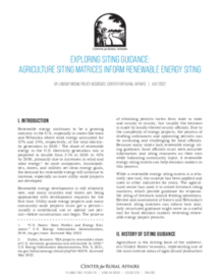Renewable energy continues to be a growing industry in the U.S., especially in states like Iowa and Nebraska where wind energy accounted for 57% and 24%, respectively, of the total electricity generation in 2020. The share of renewable energy in the U.S. electricity generation mix is projected to double from 21% in 2020 to 42% by 2050, primarily due to increases in wind and solar energy. As more companies, municipalities, states, and utilities set clean energy goals, the demand for renewable energy will continue to increase, especially as more utility-scale projects are developed.
Renewable energy development is still relatively new, and many counties and states are being approached with development requests for the first time. Utility-scale energy projects and many community-scale projects must get a permit—usually a conditional use or special use permit—before construction can begin. The process of obtaining permits varies from state to state and county to county, but usually the decision is made by locally elected county officials. Due to the complexity of energy projects, the process of drafting ordinances and approving permits can be confusing and challenging for local officials. Because many states lack renewable energy siting guidance, local officials must seek accurate information and siting resources on their own while balancing community input. A renewable energy-siting matrix can help decision makers in this process.


